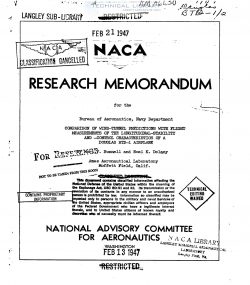naca-rm-a6l30
- Version
- 30 Downloads
- 3.40 MB File Size
- 1 File Count
- April 15, 2017 Create Date
- April 15, 2017 Last Updated
National Advisory Committee for Aeronautics, Research Memorandum - Comparison of Wind Tunnel Predictions with Flight Measurements of the Longitudinal Stability Measurements of a Douglas BTD-1 Airplane

Low Mach number longitudinal—stability and —-control
characteristics as predicted by use of windy-tunnel data from a
powered 3/l6—scale model are compared with flight-test measure—
ments of a Navy B'IED—l airplane. The accuracy of the wind-tunnel
data and the discrepancies involved. in attempting to correlate
with flight data are discussed and amlyzed.
The comparison showed that wind—tunnel predictions were, in
general, in good agreement with flight-test data. ‘l‘he predicted
values were for the most part sufficiently accurate to show the
satisfactory and unsatisfactory characteristics in the preliminary
design stage and to indicate possible methods of improvement. The
discrepancies which did occur were attributed principally to
physical dissimilarities between model and airplane and the
inability to determine accurately the flight power conditions. The
effect of Mach number was considered negligible since the maxim
flight—test value was about 0.5. In order to simulate more closely
the flight conditions and hence obtain more accurate data for
predictions, it appears desirable to perform large—scale tests of
unorthodox control surfaces such as the sealed waned elevators with
which the airplane was equipped.
The flying qualities of various types of airplanes have been
predicted during the last few years from wind—tumel measurements
01‘ powered scale models. In the past, when the predictions have
indicated unsatisfactory stability and control characteristics,
wind—tunnel data have been used as a guide in the redesign of the
airplane. The NACA has. undertaken an investigation to study the
reliability of this prediction procedure by a detailed comparison
of flight and wind-turmel data. (See references 1 and 2.)
As part of this correlation program, flight—test data on the
longitudinal—stability and ~control characteristics of a Douglas
B'IED—l airplane are compared in this report with the results of
tests at low Mach number of a powered 3/16—scale model in the Amos
7- by 10—foot wind. tunnel. The results are confined. to the follow—
ing important characteristics which are most suitable for prediction
and correlation: static longitudinal stability, elevator control
in maneuvering flight, and elevator control in landing.
| File | Action |
|---|---|
| naca-rm-a6l30 Comparison of Wind Tunnel Predictions with Flight Measurements of the Longitudinal Stability Measurements of.pdf | Download |

Comment On This Post